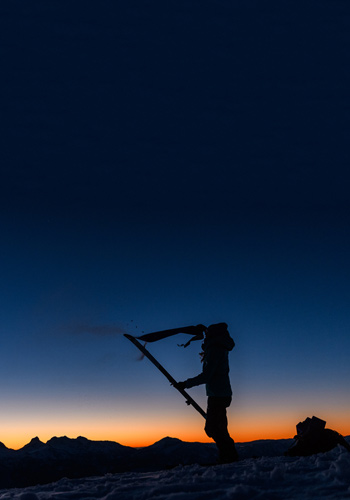A day in the mountains is best spent traveling through them, not standing around among them. And through practice and planning, it’s possible to minimize down time to earn more turns in a day. Here’s how to increase personal and group efficiency without upping the pace in the skintrack.

Christina Lustenberger clocks in for the day. Revelstoke, B.C. [Photo] Fredrik Marmsater
Stride Right
Skinning can and should feel as natural as walking. But reaching that point takes both practice and attention to detail. Maximize grip by vertically aligning your nose, knees and toes—rather than slouching forward or leaning back. Optimize efficiency by sliding skis—instead of lifting them—on each stride. Follow contours, benches and natural terrain features at moderate, consistent angles to gain elevation. And remember: skinning generally requires less energy than bootpacking, and rounded turns are speedier than kickturns.
Transitions, Dialed
Shorten downtime during transitions by dialing in your process. Focus first on the essentials—skins, boots, bindings and layers—before taking a break to eat, drink, take pictures or make a plan for what’s next. This means you’ll be ready to ski or skin when a break comes to an end, rather than still futzing with gear while everyone else is getting cold. Got a nearby skimo series? Check it out to see how quickly the pros switch modes; adopt some of their techniques or jump in and test your own quickness.
Plan Ahead
Organize your gear, food and what you’ll wear according to a day’s plan, keeping essentials like snacks or sunglasses handy in waist-belt or jacket pockets for on-the-fly access. In the mountains, once you’ve set a track, climb it more than once if it aligns with your day’s plan. And at transitions, think ahead to what comes next to minimize later stops. Should you toss on an extra layer now for an upcoming, blustery ridgeline? Will you need skins after the bootpack or could you rip them now?
Groupthink
Larger groups are undoubtedly less efficient than smaller ones. But if traveling in a big group is a must, communication is immeasurably valuable for enhancing efficiency. Radios are indispensible for keeping in contact on both the ascent and descent. At breaks, get everyone on the same page about what’s next, whether that’s how long said break might be (i.e. lunch versus a quick photo op) or the plan for descending after lunch.











Related posts:
How Tahoe-based snowboarder Ming Poon swapped business for photography
Photographer Profile: Bruno Long's in the right place at the right time
Carl Skoog: Remembering an icon of Washington ski mountaineering and photography
Reclaiming Lost Ground, Revisited